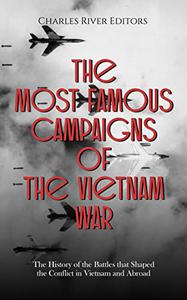

E-Books →The Most Famous Campaigns of the Vietnam War
Published by: voska89 on 22-12-2022, 18:02 |  0
0

The Most Famous Campaigns of the Vietnam War: The History of the Battles that Shaped the Conflict in Vietnam and Abroad by Charles River Editors
English | December 12, 2022 | ISBN: N/A | ASIN: B0BPZY8JNY | 310 pages | EPUB | 8.14 Mb
The Vietnam War could have been called a comedy of errors if the consequences weren't so deadly and tragic. In 1951, while war was raging in Korea, the United States began signing defense pacts with nations in the Pacific, intending to create alliances that would contain the spread of Communism. As the Korean War was winding down, America joined the Southeast Asia Treaty Organization, pledging to defend several nations in the region from Communist aggression. One of those nations was South Vietnam.
Before the Vietnam War, most Americans would have been hard pressed to locate Vietnam on a map. South Vietnamese President Diem's regime was extremely unpopular, and war broke out between Communist North Vietnam and South Vietnam around the end of the 1950s. Kennedy's administration tried to prop up the South Vietnamese with training and assistance, but the South Vietnamese military was feeble. A month before his death, Kennedy signed a presidential directive withdrawing 1,000 American personnel, and shortly after Kennedy's assassination, new President Lyndon B. Johnson reversed course, instead opting to expand American assistance to South Vietnam.
Over the next few years, the American military commitment to South Vietnam grew dramatically, and the war effort became both deeper and more complex. The strategy included parallel efforts to strengthen the economic and political foundations of the South Vietnamese regime, to root out the Viet Cong guerrilla insurgency in the south, combat the more conventional North Vietnamese Army (NVA) near the Demilitarized Zone between north and south, and bomb military and industrial targets in North Vietnam itself. In public, American military officials and members of the Johnson administration stressed their tactical successes and offered rosy predictions. At the same time, the government worked to conceal from the American public their own doubts and the grim realities of war. Reflecting on the willful public optimism of American officials at the time, Colonel Harry G. Summers concluded, "We in the military knew better, but through fear of reinforcing the basic antimilitarism of the American people we tended to keep this knowledge to ourselves and downplayed battlefield realities . . . We had concealed from the American people the true nature of the war." (Summers, 63).
By the end of 1967, with nearly half a million troops deployed, more than 19,000 deaths, and a war that cost $2 billion a month and seemed to grow bloodier by the day, the Johnson administration faced an increasingly impatient and skeptical nation. Early in 1968, a massive coordinated Viet Cong operation - the Tet Offensive - briefly paralyzed American and South Vietnamese forces across the country, threatening even the American embassy compound in Saigon. With this, the smiling mask slipped even further, inflaming the burgeoning antiwar movement. As the results of the Tet Offensive made clear, American forces were hamstrung by political constraints and a wide range of self-imposed limitations, and the United States struggled to deal with the greater strategic nimbleness of the North Vietnamese during the late 1960s. The tremendous power of the American military, blending technological strength and professional skill, gave the Americans the advantage in many, though of course not all, tactical encounters. On the strategic and operational level, however, the North Vietnamese held many of the trump cards. Constrained by a heavily defensive strategy, the U.S. found itself mostly forced to respond to the North's initiatives, and a reactive strategy placed even an extremely potent combatant at a severe disadvantage.
By 1975, the NVA prepared for a final series of campaigns to conquer the territory of South Vietnam, leading to a chain of events that culminated with the fall of Saigon and some of the most infamous footage in 20th century America's history.
Buy Premium From My Links To Get Resumable Support,Max Speed & Support Me
Download From 1DL
https://1dl.net/hvu4rs70avjv/aqecv.T.M.F.C.o.t.V.W.rar

https://rapidgator.net/file/c630d24597cf901fb2d9b08914d81e97/aqecv.T.M.F.C.o.t.V.W.rar.html

https://nitroflare.com/view/D3F04F2F1FBE76D/aqecv.T.M.F.C.o.t.V.W.rar

https://uploadgig.com/file/download/3977E84E2109Ebb7/aqecv.T.M.F.C.o.t.V.W.rar
https://1dl.net/hvu4rs70avjv/aqecv.T.M.F.C.o.t.V.W.rar

https://rapidgator.net/file/c630d24597cf901fb2d9b08914d81e97/aqecv.T.M.F.C.o.t.V.W.rar.html

https://nitroflare.com/view/D3F04F2F1FBE76D/aqecv.T.M.F.C.o.t.V.W.rar

https://uploadgig.com/file/download/3977E84E2109Ebb7/aqecv.T.M.F.C.o.t.V.W.rar
Links are Interchangeable - No Password - Single Extraction
Related News
-
{related-news}

